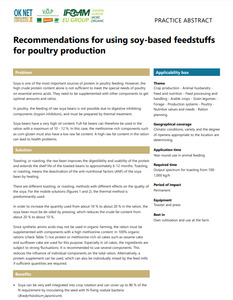{Tool} Recommendations for using soy-based feedstuffs for poultry production (OK-Net Ecofeed Practice Abstract). [Empfehlungen zur Verwendung von Futtermitteln auf Sojabasis für die Geflügelproduktion.] Creator(s): Lindner, Christopher and Schmelzer, Elias. Issuing Organisation(s): Bioland Beratung. OK-Net Ecofeed Practice Abstract, no. 026. (2020)
|
PDF
- English
(Recommendations for using soy-based feedstuffs for poultry production)
196kB | |
|
PDF
- German/Deutsch
(Empfehlungen zur Verwendung von Futtermitteln auf Sojabasis für die Geflügelproduktion)
195kB | |
![[thumbnail of 2022-07-27 19_40_37-PA_00037896_L0.pdf.png]](/37896/5.hassmallThumbnailVersion/2022-07-27%2019_40_37-PA_00037896_L0.pdf.png)  Preview |
Image (PNG)
- Cover Image
- English
93kB |
Document available online at: https://orgprints.org/37896
Summary in the original language of the document
Benefits
• Soya can be very well integrated into crop rotation and can cover up to 80 % of the N requirement by inoculating the seed with N-fixing nodule bacteria (Bradyrhizobium japonicum).
• High added value through refinement in own plant. Soya contains a lot of energy and protein. It is very tasty for the animals and easy to digest. The high content of linoleic acid has a positive effect on the egg size of laying hens.
• Dependence on soya imports can be reduced
• The pressed oil can be sold for further use.
Practical recommendation
• Soya toasting and de-oiling is now well established and the process steps are defined (temperature and duration), but availability of mobile soya toasting plants must be ensured.
| EPrint Type: | Practice tool |
|---|---|
| What problem does the tool address?: | Soya is one of the most important sources of protein in poultry feeding. However, the high crude protein content alone is not sufficient to meet the special needs of poultry on essential amino acids. They need to be supplemented with other components to get optimal amounts and ratios. In poultry, the feeding of raw soya beans is not possible due to digestive inhibiting components (trypsin inhibitors), and must be prepared by thermal treatment. Soya beans have a very high oil content. Full-fat beans can therefore be used in the ration with a maximum of 10 - 12 %. In this case, the methionine-rich components such as corn gluten must also have a low raw fat content. A high raw fat content in the ration can lead to health problems. |
| What solution does the tool offer?: | Toasting, or roasting, the raw bean improves the digestibility and usability of the protein and extends the shelf life of the toasted beans to approximately 6-12 months. Toasting, or roasting, means the deactivation of the anti-nutritional factors (ANF) of the soya bean by heating. There are different toasting, or roasting, methods with different effects on the quality of the soya. For the mobile solutions (figures 1 and 2), the thermal method is predominantly used. In order to increase the quantity used from about 10 % to about 20 % in the ration, the soya bean must be de-oiled by pressing, which reduces the crude fat content from about 20 % to about 10 %. Since synthetic amino acids may not be used in organic farming, the ration must be supplemented with components with a high methionine content. In 100% organic rations (check Table 1) rice protein or methionine-rich oil cakes such as sesame cake and sunflower cake are used for this purpose. Especially in oil cakes, the ingredients are subject to strong fluctuations. It is recommended to use several components. This reduces the influence of individual components on the total ration. Alternatively, a protein supplement can be used, which can also be individually mixed by the feed mills if sufficient quantities are required. |
| Country: | Germany |
| Type of Practice Tool: | Practice abstracts |
| Keywords: | animal husbandry, poultry, feeds, feedstuffs, soybeans, legumes, soya, feed processing, harvested feed |
| Agrovoc keywords: | Language Value URI English animal husbandry http://aims.fao.org/aos/agrovoc/c_8532 English feed processing http://aims.fao.org/aos/agrovoc/c_16127 English feeds http://aims.fao.org/aos/agrovoc/c_2843 English legumes http://aims.fao.org/aos/agrovoc/c_4255 English layer chickens http://aims.fao.org/aos/agrovoc/c_12109 English broiler chickens http://aims.fao.org/aos/agrovoc/c_9435 |
| Subjects: | Animal husbandry > Feeding and growth Animal husbandry > Production systems > Poultry |
| Research affiliation: | European Union > Horizon 2020 > OK-Net EcoFeed European Union > Horizon 2020 > OK-Net EcoFeed > OK-Net Ecofeed Tools Germany > Bioland European Union > Organic Farm Knowledge |
| Horizon Europe or H2020 Grant Agreement Number: | 773911 |
| Related Links: | https://organic-farmknowledge.org/tool/37896, https://orgprints.org/37896, https://www.bioland.de, https://www.facebook.com/organicfarmknowledge/photos/a.341364110046066/687840778731729, https://twitter.com/farm_knowledge/status/1268572323126353920 |
| Project ID: | ofk |
| Deposited By: | Forschungsinstitut für biologischen Landbau, FiBL |
| ID Code: | 37896 |
| Deposited On: | 29 May 2020 09:11 |
| Last Modified: | 02 May 2024 10:32 |
| Document Language: | English, German/Deutsch |
| Status: | Published |
Repository Staff Only: item control page

 Download Statistics
Download Statistics Download Statistics
Download Statistics
